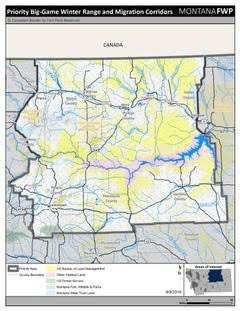New agreement will provide $550,000 for Michigan pheasant habitat restoration

The Michigan Department of Natural Resources is partnering with Enbridge Energy Partners, L.P. and Pheasants Forever in an agreement that will see Enbridge provide half a million dollars for pheasant habitat restoration in Michigan.
Improvement projects are scheduled to take place over the next three years in various areas in Michigan, focused on Michigan Pheasant Restoration Initiative priority landscapes and oak savanna restoration.
“This partnership allows the parties involved to work together cooperatively, producing significant habitat improvements for wildlife and the betterment of upland game hunting opportunities,” said DNR Director Keith Creagh.
In 2013, Enbridge replaced a 30-inch pipeline, which runs for about two miles across the Crane Pond State Game Area in Cass County. As a result of the permitting process, the DNR and Enbridge worked together to improve the pipeline infrastructure and restore and improve habitat impacted during construction.
Enbridge transports, generates and distributes energy, employing more than 11,000 workers, mostly in the U.S. and Canada.
“Operating in the state for more than 60 years, Enbridge considers Michigan home and we are committed to protecting its abundant natural beauty and wildlife,” said John Gauderman, Enbridge director, Chicago Region. “We are proud to partner with the Michigan Department of Natural Resources to support Pheasants Forever and the work it does in wildlife conservation and preserving the state’s pheasant population for future generations to enjoy.”
Enbridge has been working with the DNR on projects to restore prairie habitat at the 4,200-acre game area disrupted during the replacement of the pipeline. Those efforts have included prairie habitat plant seeding and removal of hedgerows to create contiguous grassland.
“The DNR and Enbridge have worked closely together for a number of years now on the pipeline project through the Crane Pond State Game Area,” said Steve Chadwick, assistant chief for the DNR Wildlife Division. “This partnership has resulted in grassland habitat restoration on land adjacent to, and directly impacted by, the pipeline construction. This grassland habitat will secure the future of wildlife species like pheasants, rabbits, and deer along with a host of songbirds and pollinating insects.”
Parties in the cooperative agreement met Monday at the Crane Pond State Game Area to celebrate the pact providing $550,000 for pheasant habitat.To finalize work on the pipeline, Enbridge will provide $500,000 for habitat activities at mutually agreeable locations. Pheasants Forever will administer the projects, provide direct oversight and produce a final accomplishments report within three years.
The DNR will also contribute $50,000 of in-kind services to the habitat restoration efforts.
Bill Vander Zouwen is the Michigan Region representative for Pheasants Forever, a group dedicated to conservation
of pheasants, quail and other wildlife through habitat improvements, public awareness, education and land management policies and programs.
Vander Zouwen was a biologist and chief of the wildlife ecology section of the Wisconsin DNR for more than 30 years before returning to Michigan.
“Pheasants Forever – The Habitat Organization – is pleased to play a significant role in grassland restoration for wildlife and hunting across southern Michigan,” Vander Zouwen said. “We have used several DNR wildlife habitat grants and matching chapter funds to improve grassland habitat on state game areas and recreation areas.”
The cooperative agreement is expected to further that continuing work.
“The Enbridge funds will provide a very nice boost to our efforts to improve key public lands in Michigan Pheasant Restoration Initiative counties,” Vander Zouwen said. “Pheasants Forever is happy to play a key role in making these projects happen and we’re thankful that the DNR and Enbridge have entrusted us with this responsibility.”
Since the “golden days” of Michigan pheasant hunting in the 1950s, changes in agricultural practices and land use have contributed to pheasant habitat loss, declining food sources and lower production of chicks.
Over the first five years of the Michigan Pheasant Recovery Initiative, the DNR has enhanced or restored roughly 7,400 acres of grasslands on state game, wildlife and recreation areas and established 3,160 acres of food plots.Bill Vander Zouwen, Michigan Region representative for Pheasants Forever, looks at a male pheasant he shot in a pheasant habitat improvement area.
Another 556 acres of enhanced grasslands and 203 acres of food plots have been cultivated around the Sharonville State Game Area, just to the north of the Hillsdale-Lenawee-Monroe focus area.
In addition, the DNR has acquired 742 acres to add to existing game areas within three priority Pheasant Recovery Areas. There have also been 765 acres of grasslands and 2,000 acres of food plots established at the Allegan State Game Area, which is located outside the existing focus areas.
The Crane Pond State Game Area is located near Three Rivers, Michigan, roughly between Kalamazoo and Elkhart, Indiana. The Crane Pond, Fabius and Three Rivers state game areas are located within about five miles of each other, all with similar soils and wildlife communities.
Crane Pond was approved as a game area by the state Conservation Commission in November 1939. Early documents characterized the area’s bobwhite and rabbits as plentiful and ring-necked pheasants, squirrels and raccoons as common.
The first land purchases were made in 1951, with land purchases in each subsequent decade until the final acquisition in 2013.
Management prescriptions for the game area have been to maintain mostly upland game populations for hunting in line with the Pittman-Robertson Act, whose proceeds aided in funding the game area’s land purchases.
Deer hunting is popular in the area, as is waterfowl hunting, turkey hunting and fishing for panfish, bass and northern pike.
A 2015 master plan for the three state game areas, including Crane Pond, outlines several goals, objectives and actions for habitat improvement and restoration, including that for ring-necked pheasants and white-tailed deer.
Learn more about the Crane Pond State Game Area or find out more information on pheasants.




